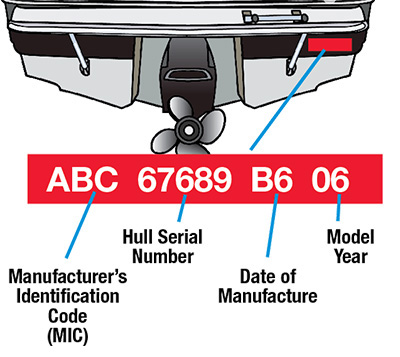The first three characters in every HIN are a Manufacturer Identification Code such as ABC. The only way to obtain a Manufacturer Identification Code is to request one from the Coast Guard. The Coast Guard will issue a Manufacturer Identification Code only to U.S. builders ofrecrea tional boats and to U.S. importers of foreign-built boats.
U.S. builders and importers may obtain a Manufacturer Identification Code by sending a letter to Commandant (G-NAB-6), U.S. Coast Guard, Washington, D.C. 20593-0001 and requesting one. The letter should briefly describe the types and sizes of boats the company will manufacture or import.

Occasionally companies are purchased and renamed. A corporation is a legal entity which does not cease functioning with a change in its owner ship. Therefore, it is responsible for its past production and the Coast Guard will not issue a new Manufacturer Identification Code. On the other hand, if a corporation goes out of business and someone merely “buys” its name and manufacturing assets, then a new business is created. The new business is not obligated to take responsibility for the past production of the defunct corporation, and we will issue a new Manufacturer Identification Code.
In the case of boats imported from Canada, the U.S. importer does not need to obtain a Manufacturer Identification Code or affix the HIN. Manufacturer Identification Codes issued by Transport Canada and HINs affixed to Canadian-built boats are compatible with the U.S. system. For boats built or imported by an individual for his or her own use, the entire 12 character HIN is assigned by the State boating authorities in the State of principal use. The HIN regulations do not apply to sailboards; however, we do not prohibit builders of sailboards from applying for Manufacturer Identification Codes and affixing HIN’s if they so desire, but there is no enforcement of the HIN regulation.
The HIN regulations also do not apply to commercial boats. However, with increased emphasis on State registration and titling (many undocumented commercial vessels are registered), and tracing of stolen boats, the Coast Guard encourages manufacturers of commercial boats to affix Hull Identification Numbers.
Again, there is no enforcement of the HIN regulation or enforcement of compliance with the other safety standards applicable to manufacturers of recreational boats. However, this exception to enforcement is dependent upon the builder’s proving to the Coast Guard’s satisfaction that the company does, in fact, build commercial boats, and is not attempting to circumvent compliance with applicable regulations.
PROBLEMS IN THE FIELD
1. “The Amalgamated Boat Company” decides it’s going to start building boats. Amalgamated decides it’s going to use “ABC”. Unfortunately, the Coast Guard previously assigned “ABC” to the “Allegheny Bateaux Corp.” in November 1973. Amalgamated’s assigning itself a Manufacturer Identification Code is illegal. Only the Coast Guard may assign a Manufacturer Identification Code.
2. “The Three Brothers Canoe Company” applies for a Manufacturer Identification Code and specifically requests “TBC” or “BCC”. We will make every effort to accommodate builders with the codes they desire; however, the Coast Guard has been issuing the codes since 1972. Therefore, we can’t always issue codes corresponding to every company’s initials.
3. Some State boat registration authorities have been unwilling to register boats with a Hull Identification Number in which the third character is a number. They mistakenly assume the HIN regulations prohibit the use of a number in the Manufacturer Identification Code and that someone is doing something illegal.
Some boat manufacturers have more than one plant and need more than one Manufacturer Identification Code. Therefore, the Coast Guard will occasionally assign a code to a builder which has a number in it.
4. Private Label Merchandisers (PLMs) and foreign manufacturers have tried to obtain a Manufacturer Identification Code. The Coast Guard uses the Manufacturer Identification Code to identify the company responsible for defect notification. A Private Label Merchandiser is not the physical manufacturer of a boat and the Coast Guard has no legal recourse against a foreign manufacturer whose boats fail to comply with Federal regulations. Therefore, we do not issue Manufacturer Identification Codes to PLMs or foreign builders (only importers).
5. Boat builders frequently change their company names and addresses and continue to manufacture boats using a specific Manufacturer Identification Code. Correspondence with such companies is frequently returned marked “Moved – Left No Address”. Builders who change their company names or relocate to new addresses are required to report such changes to the Coast Guard (see 33 CFR 181.33(b)).
